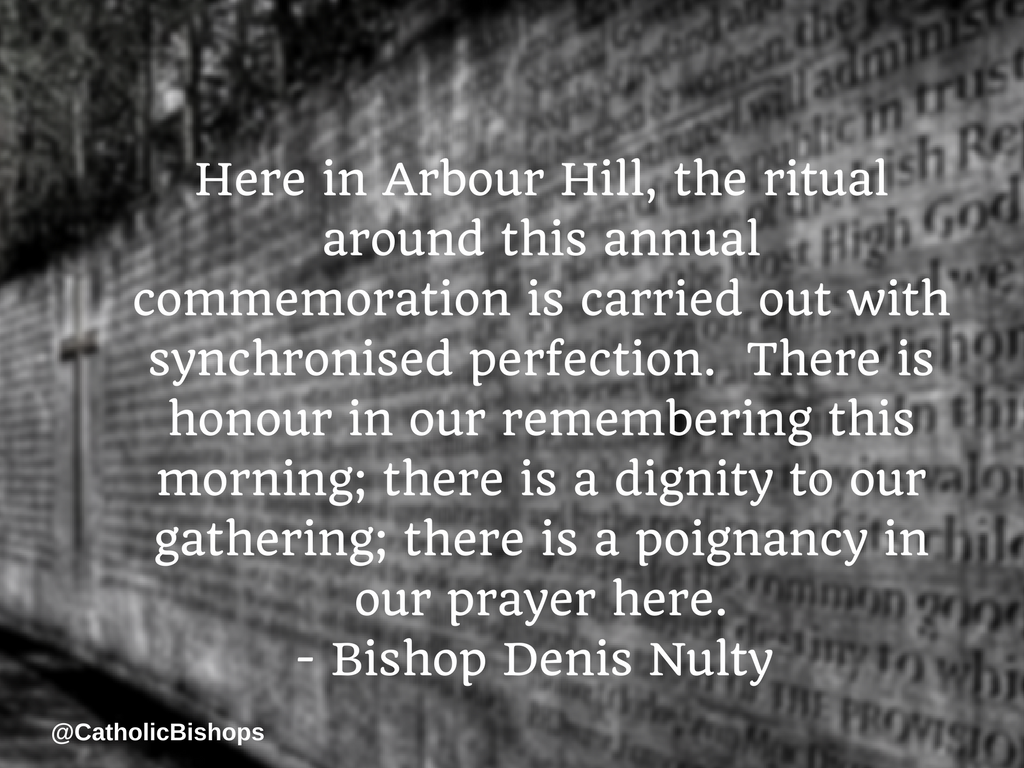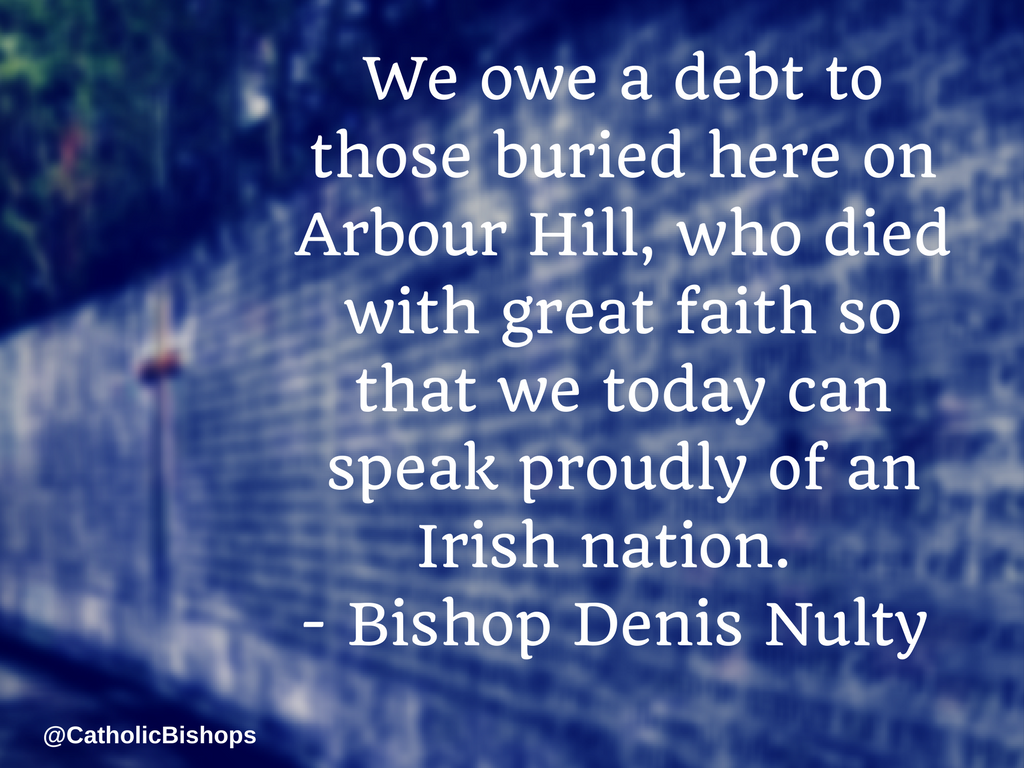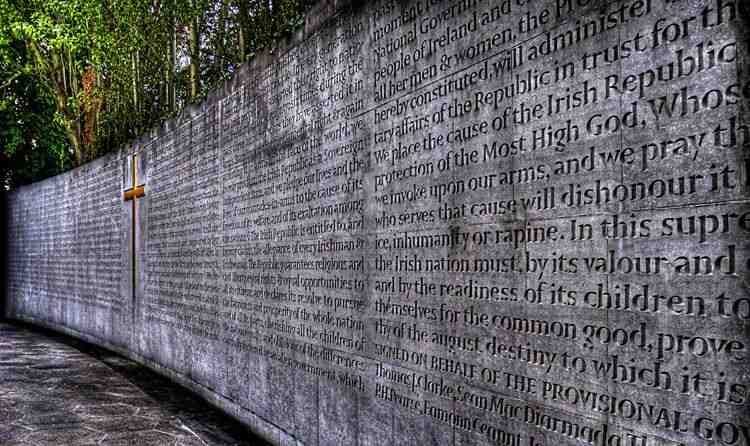Bishop Denis Nulty of Kildare and Leighlin has said that we owe a debt to those buried at Arbour Hill, who died with great faith so that we today can speak proudly of an Irish nation. Bishop Nulty was speaking at the annual Mass of Remembrance celebrating the State Commemoration of all who died in the 1916 Easter Rising. The Mass took place in the Church of the Sacred Heart – the church of the Defence Forces – in Arbour Hill, Dublin, today, Wednesday 3 May.
Today’s Mass was attended by President Michael D. Higgins, and Taoiseach Enda Kenny.
In his introduction to the Mass, Bishop Nulty said, “It is a year beyond the centenary, perhaps a little less fanfare and commemoration than last year’s memorable events, but our celebration is all the more sacred and sincere. Loved ones never forget, and perhaps that is why the Irish tradition of ‘cemetery devotions’ is a very strong part of our psyche. We like to visit the graves, to read the headstones, to see the sprinkling of the water.
“Here in Arbour Hill, the ritual around this annual commemoration is carried out with synchronised perfection. There is honour in our remembering this morning; there is a dignity to our gathering; there is a poignancy in our prayer here. 
“The Christ we meet this Eastertime is a wounded Risen Christ, we gather as a wounded people in a place that understands the wounds of the past more than most, but equally a place that can offer huge hope for the future.”
In his homily, Bishop Nulty said, “We have gathered in the sacred surrounds of Arbour Hill to remember those who died 101 years ago this week. This morning we have come from all religious traditions to seek God’s face and what a different world it would be if we all took time to look on His face and to take Saint Matthew’s words in our gospel to heart: loving enemies, blessing those who curse us, praying for those who treat us badly.
“We gather as families of a grateful nation to pray for the repose of the souls of those whose graves we will shortly sprinkle with Holy Water. This is very like a National Cemetery Sunday, except for the fact that the names and photos of those we honour today are not just in a memorial card in someone’s prayer book back in our home or on a bookmarker in the latest novel we’re reading; these names are etched in Irish and in English in Wicklow Ardbraccan limestone around their final resting place. They are the names and faces known throughout the country following last year’s dignified Centenary Celebrations centering on the Proclamation and Flag in all our schools. I remember from my own school days the 1916 poster, presented then in 1966, that hung on the corridor of Saint Patrick’s National School in Slane, in County Meath.”
Bishop Nulty continued, “I equally remember on that same school corridor close to the 1916 poster, the slightly fading sepia portrait of a young man, Francis Ledwidge, also from the parish, who enlisted in the British army in 1914. On hearing of the Easter Rising and the execution of a fellow-poet, Thomas McDonagh, he wrote a lament before he died horrifically himself on the first day of the battle of Passchendaele on 31 July 1917. As our thirteen year-old creative writer Katelyn reminded us death is the one weapon all of us should fear, Ledwidge had similar thoughts in his mind as he wrote this lament. A lament known to my school friends and my former teachers who I meet at the graveside on Cemetery Sunday, and indeed I imagine by all of you present here this morning, you might like to recite this verse with me:
“He shall not hear the bittern cry
in the wild sky, where he is lain,
nor voices of the sweeter birds
above the wailing of the rain”
“He was twenty-nine years of age. Although he witnessed the horrors of war, those horrors never seemed to impinge on his poetry; the late Séamus Heaney suggested he used ‘pastoral recourse’, harping back to his days along the Boyne or listening to the blackbird, rather than dwell on the mud of the trenches or the smell of gunpowder. It would be foolhardy for us to guess what were the final thoughts of those buried here in Arbour Hill. Perhaps they too at their final hour thought of home, family and faith.”
Bishop Nulty went on to recall 1916 and some of the names from the Diocese of Kildare and Leighlin etched into the history books. He said, “I recall Michael O’Hanrahan, brought up in the shadow of our Cathedral in Carlow, executed on 4 May 1916. I also think of Gearóid Ó Suilleabháin, a native of West Cork and a cousin of Michael Collins. He had the honour of raising the tricolour over the GPO on Easter Monday 1916. At the end of that year he became Professor of Irish in our Diocesan College of Knockbeg. In a matter of months he had transformed the college into an Irish speaking school. Ó Suilleabháin was a deeply spiritual man who as well as achieving remarkable academic success in the College, was very active in organising the Volunteers in the Carlow area. He confided later that when he got back to the College every night after patrolling the countryside around Carlow on his bike, he used to kneel down and pray the Rosary offering it for the intention that God would give him the grace not to neglect his College duties, because of his volunteer activities!”
Bishop Nulty went on to say, “One hundred and one years later, cadets today stand guard at the grave of Michael O’Hanrahan and his executed colleagues. The Military Police will present a wreath to an tUachtarán and when the wreath has been laid we will observe a minute of silent prayer and reflection. The stillness and silence will be broken by a single drumbeat as we wait for The Last Post, the raising of the Tricolour, the Reveille and the National Anthem.
“At the altar this morning, during this Easter season, we consider the prayers of the 1916 leaders, their faith and the risks they took that Easter week. What prayers will fill our minute of silence as we wait for that drumbeat in a short while? What thoughts will fill our hearts as we watch the flag being raised and once again hear the National Anthem? Perhaps we will think back to Gearóid Ó Suilleabháin and all the other less well known heroes of 1916? We might also reflect the respect due to its flag by every nation and equally the moments and events where that flag becomes a weapon or an instrument of destruction.”

Bishop Nulty went on to pay tribute to the men and women of the Defence Forces and to Ireland’s role in peace-keeping. He said, “In a diocese that uniquely has a parish of the Defence Forces – the Curragh – I pay tribute to the many women and men who with great pride in flag and country represent us on many peacekeeping missions.”
Concluding his homily Bishop Nulty recalled recent remarks by Pope Francis on the role of smaller nations like Ireland in world peace. He said, “Pope Francis reminds us little nations can play a significant role in world peacekeeping in his call on Norway to mediate in the current dispute between North Korea and the United States. The personnel of Óglaigh na hÉireann are equally equipped to mediate and have done so with great success in the past. Saint Matthew reminds us the amount you measure out, is the amount you will be given back. We are all passing through this world, each one is challenged to make a difference.”
ENDS


